Analysis of the Criminal Justice System and English Legal System
VerifiedAdded on 2021/02/21
|9
|2466
|22
Report
AI Summary
This report provides a detailed overview of the English legal system, encompassing various types of laws such as civil, criminal, common, and statutory law. It explores the principles of criminal law, including judicial precedent, mens rea, actus reus, and the burden and standard of proof. The report further analyzes the structure and function of Magistrate and Crown Courts, including the roles of magistrates, judges, and juries. It outlines the appeal process within the criminal court structure, emphasizing the court hierarchy and the right to appeal. Finally, the report critically examines how a criminal offense is handled within the criminal justice system, highlighting the procedures and frameworks designed to ensure impartial decision-making. The report aims to enforce the understanding of the legal system in relation to the criminal justice system.

LAW AND LEGAL
SYSTEM
SYSTEM
Paraphrase This Document
Need a fresh take? Get an instant paraphrase of this document with our AI Paraphraser

Table of Contents
INTRODUCTION...........................................................................................................................3
MAIN BODY...................................................................................................................................3
TASK 1............................................................................................................................................3
P1 Different types of laws in the English legal system...............................................................3
P2. Main principals of the criminal law......................................................................................4
M1 Evaluation of different types and principals of the law to particular offence......................5
TASK 2............................................................................................................................................5
P3 Structure of magistrate and crown courts..............................................................................5
P4 The route for appeal in the criminal court structure..............................................................7
M2 Analyse of structures of the Magistrates and Crown Courts for criminal proceedings.......7
D1. how the criminal justice system works by critically analysing how a particular criminal
offence would be dealt with........................................................................................................8
CONCLUSION ...............................................................................................................................8
REFERENCES................................................................................................................................9
INTRODUCTION...........................................................................................................................3
MAIN BODY...................................................................................................................................3
TASK 1............................................................................................................................................3
P1 Different types of laws in the English legal system...............................................................3
P2. Main principals of the criminal law......................................................................................4
M1 Evaluation of different types and principals of the law to particular offence......................5
TASK 2............................................................................................................................................5
P3 Structure of magistrate and crown courts..............................................................................5
P4 The route for appeal in the criminal court structure..............................................................7
M2 Analyse of structures of the Magistrates and Crown Courts for criminal proceedings.......7
D1. how the criminal justice system works by critically analysing how a particular criminal
offence would be dealt with........................................................................................................8
CONCLUSION ...............................................................................................................................8
REFERENCES................................................................................................................................9
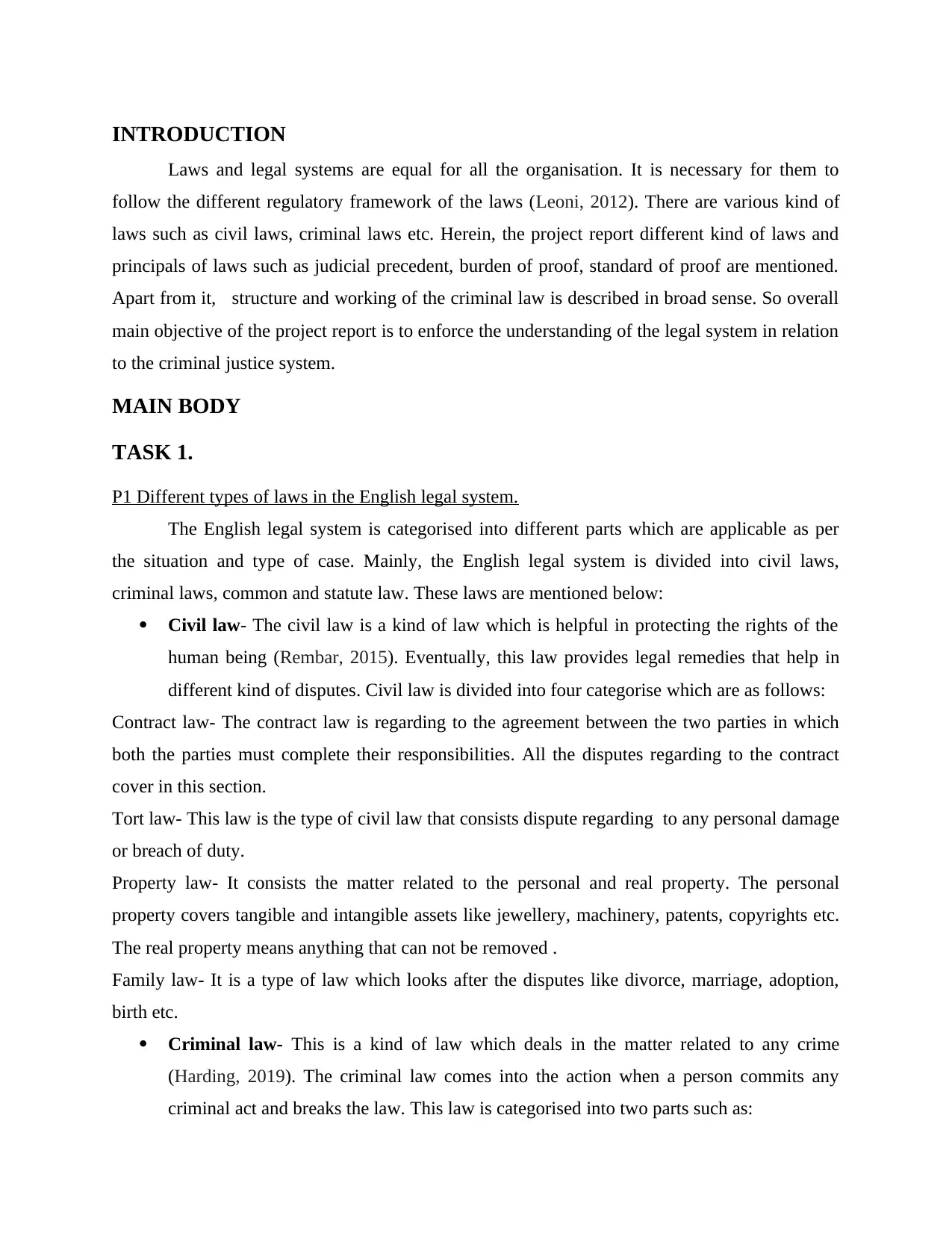
INTRODUCTION
Laws and legal systems are equal for all the organisation. It is necessary for them to
follow the different regulatory framework of the laws (Leoni, 2012). There are various kind of
laws such as civil laws, criminal laws etc. Herein, the project report different kind of laws and
principals of laws such as judicial precedent, burden of proof, standard of proof are mentioned.
Apart from it, structure and working of the criminal law is described in broad sense. So overall
main objective of the project report is to enforce the understanding of the legal system in relation
to the criminal justice system.
MAIN BODY
TASK 1.
P1 Different types of laws in the English legal system.
The English legal system is categorised into different parts which are applicable as per
the situation and type of case. Mainly, the English legal system is divided into civil laws,
criminal laws, common and statute law. These laws are mentioned below:
Civil law- The civil law is a kind of law which is helpful in protecting the rights of the
human being (Rembar, 2015). Eventually, this law provides legal remedies that help in
different kind of disputes. Civil law is divided into four categorise which are as follows:
Contract law- The contract law is regarding to the agreement between the two parties in which
both the parties must complete their responsibilities. All the disputes regarding to the contract
cover in this section.
Tort law- This law is the type of civil law that consists dispute regarding to any personal damage
or breach of duty.
Property law- It consists the matter related to the personal and real property. The personal
property covers tangible and intangible assets like jewellery, machinery, patents, copyrights etc.
The real property means anything that can not be removed .
Family law- It is a type of law which looks after the disputes like divorce, marriage, adoption,
birth etc.
Criminal law- This is a kind of law which deals in the matter related to any crime
(Harding, 2019). The criminal law comes into the action when a person commits any
criminal act and breaks the law. This law is categorised into two parts such as:
Laws and legal systems are equal for all the organisation. It is necessary for them to
follow the different regulatory framework of the laws (Leoni, 2012). There are various kind of
laws such as civil laws, criminal laws etc. Herein, the project report different kind of laws and
principals of laws such as judicial precedent, burden of proof, standard of proof are mentioned.
Apart from it, structure and working of the criminal law is described in broad sense. So overall
main objective of the project report is to enforce the understanding of the legal system in relation
to the criminal justice system.
MAIN BODY
TASK 1.
P1 Different types of laws in the English legal system.
The English legal system is categorised into different parts which are applicable as per
the situation and type of case. Mainly, the English legal system is divided into civil laws,
criminal laws, common and statute law. These laws are mentioned below:
Civil law- The civil law is a kind of law which is helpful in protecting the rights of the
human being (Rembar, 2015). Eventually, this law provides legal remedies that help in
different kind of disputes. Civil law is divided into four categorise which are as follows:
Contract law- The contract law is regarding to the agreement between the two parties in which
both the parties must complete their responsibilities. All the disputes regarding to the contract
cover in this section.
Tort law- This law is the type of civil law that consists dispute regarding to any personal damage
or breach of duty.
Property law- It consists the matter related to the personal and real property. The personal
property covers tangible and intangible assets like jewellery, machinery, patents, copyrights etc.
The real property means anything that can not be removed .
Family law- It is a type of law which looks after the disputes like divorce, marriage, adoption,
birth etc.
Criminal law- This is a kind of law which deals in the matter related to any crime
(Harding, 2019). The criminal law comes into the action when a person commits any
criminal act and breaks the law. This law is categorised into two parts such as:
⊘ This is a preview!⊘
Do you want full access?
Subscribe today to unlock all pages.

Trusted by 1+ million students worldwide

Misdemeanour- It consists lower level criminal acts like petty thefts, breaking the traffic etc. The
basic penalty for the misdemeanour crime is of one year or less then one year.
Felony- This contains higher level crimes such as murder, rap robbery etc. General penalty in
this crime is of one or more years. It depends on the type of case or matter.
Common law- It is a type of law which is applicable to a particular group on the basis of
legal precedents and customs that have developed over the 100 years in the Britain
(Capra and Mattei, 2015). This is law is practised into different kind of countries such as
Australia, Canada, United kingdom, India and New Zealand.
Statuary law- This is a kind of law which is in a written form adopted by the legislative
body and opposed to the administrative law. In this law the statutes are being created by
the local government, federal government or any other body.
P2. Main principals of the criminal law.
The criminal law contains some principals which are judicial precedent, avoiding
precedent, binding court hierarchy, mens rea, actus reus, burden of proof and standard of proof.
Eventually, these principals are necessary to the criminal law. Herein, detail description of these
principals is mentioned below:
1. Judicial precedent- It may be defined as a kind of process in which judge of court
implements past decided cases in which facts are similar to the current case. This is the
basic principal of the criminal law. The disadvantage of the judicial precedent is that it
creates the complexity.
2. Avoiding precedent- This is opposite of the above mentioned principal. In this court does
not follow the procedures and facts of the previous case. The reason behind this is that
terms and facts of the current court are different from the previous case.
3. Binding court hierarchy- The hierarchy of the courts consist a wide range of courts that
are being categorised at different level such as federal, state and territory level. Among
different courts, the upper level court is the high court.
4. Mens rea- It is related with the mental element of a person whose intention to conduct
any crime. In other words, it may be defined as the knowledge or lack of knowledge by
which an individual do any criminal activity.
basic penalty for the misdemeanour crime is of one year or less then one year.
Felony- This contains higher level crimes such as murder, rap robbery etc. General penalty in
this crime is of one or more years. It depends on the type of case or matter.
Common law- It is a type of law which is applicable to a particular group on the basis of
legal precedents and customs that have developed over the 100 years in the Britain
(Capra and Mattei, 2015). This is law is practised into different kind of countries such as
Australia, Canada, United kingdom, India and New Zealand.
Statuary law- This is a kind of law which is in a written form adopted by the legislative
body and opposed to the administrative law. In this law the statutes are being created by
the local government, federal government or any other body.
P2. Main principals of the criminal law.
The criminal law contains some principals which are judicial precedent, avoiding
precedent, binding court hierarchy, mens rea, actus reus, burden of proof and standard of proof.
Eventually, these principals are necessary to the criminal law. Herein, detail description of these
principals is mentioned below:
1. Judicial precedent- It may be defined as a kind of process in which judge of court
implements past decided cases in which facts are similar to the current case. This is the
basic principal of the criminal law. The disadvantage of the judicial precedent is that it
creates the complexity.
2. Avoiding precedent- This is opposite of the above mentioned principal. In this court does
not follow the procedures and facts of the previous case. The reason behind this is that
terms and facts of the current court are different from the previous case.
3. Binding court hierarchy- The hierarchy of the courts consist a wide range of courts that
are being categorised at different level such as federal, state and territory level. Among
different courts, the upper level court is the high court.
4. Mens rea- It is related with the mental element of a person whose intention to conduct
any crime. In other words, it may be defined as the knowledge or lack of knowledge by
which an individual do any criminal activity.
Paraphrase This Document
Need a fresh take? Get an instant paraphrase of this document with our AI Paraphraser
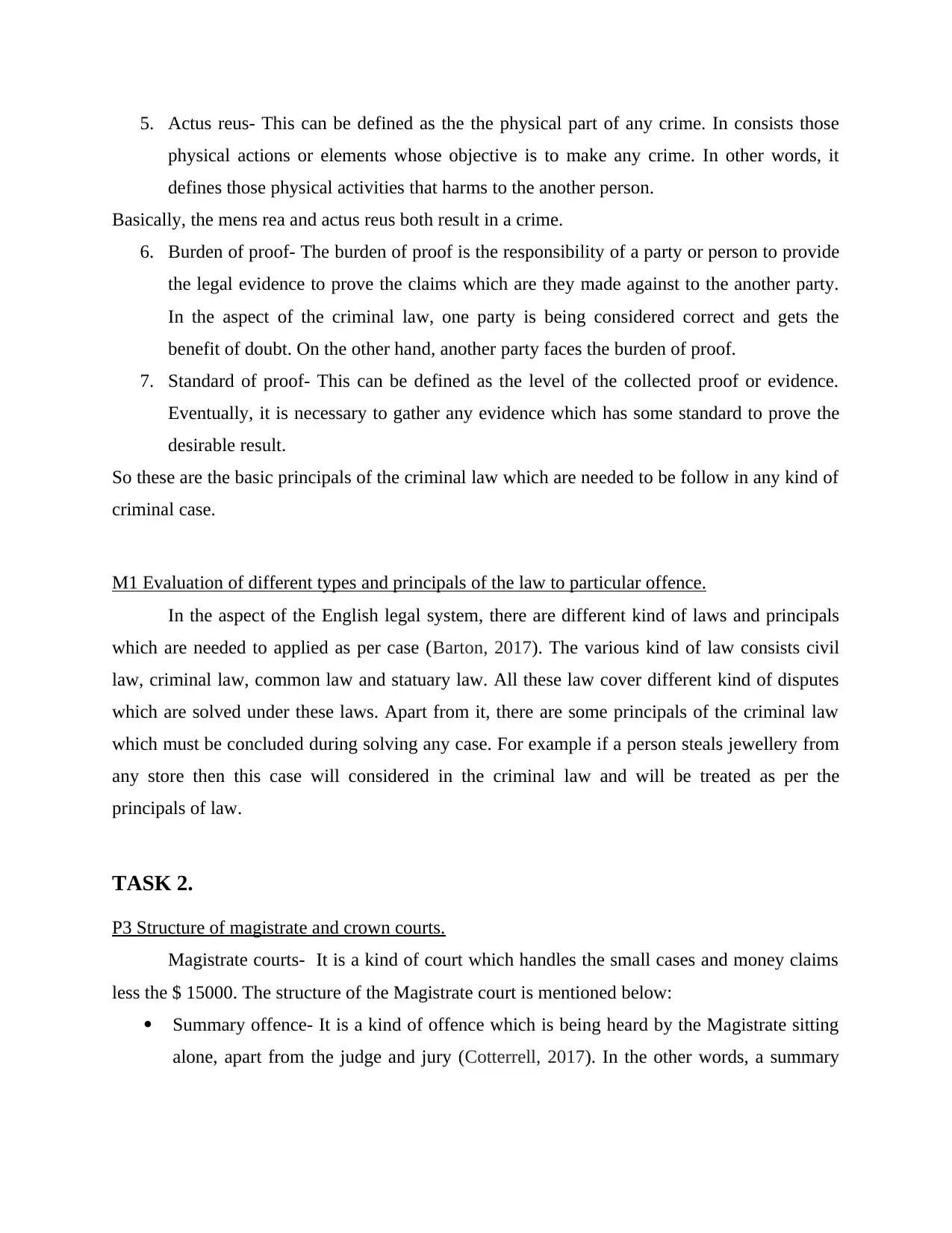
5. Actus reus- This can be defined as the the physical part of any crime. In consists those
physical actions or elements whose objective is to make any crime. In other words, it
defines those physical activities that harms to the another person.
Basically, the mens rea and actus reus both result in a crime.
6. Burden of proof- The burden of proof is the responsibility of a party or person to provide
the legal evidence to prove the claims which are they made against to the another party.
In the aspect of the criminal law, one party is being considered correct and gets the
benefit of doubt. On the other hand, another party faces the burden of proof.
7. Standard of proof- This can be defined as the level of the collected proof or evidence.
Eventually, it is necessary to gather any evidence which has some standard to prove the
desirable result.
So these are the basic principals of the criminal law which are needed to be follow in any kind of
criminal case.
M1 Evaluation of different types and principals of the law to particular offence.
In the aspect of the English legal system, there are different kind of laws and principals
which are needed to applied as per case (Barton, 2017). The various kind of law consists civil
law, criminal law, common law and statuary law. All these law cover different kind of disputes
which are solved under these laws. Apart from it, there are some principals of the criminal law
which must be concluded during solving any case. For example if a person steals jewellery from
any store then this case will considered in the criminal law and will be treated as per the
principals of law.
TASK 2.
P3 Structure of magistrate and crown courts.
Magistrate courts- It is a kind of court which handles the small cases and money claims
less the $ 15000. The structure of the Magistrate court is mentioned below:
Summary offence- It is a kind of offence which is being heard by the Magistrate sitting
alone, apart from the judge and jury (Cotterrell, 2017). In the other words, a summary
physical actions or elements whose objective is to make any crime. In other words, it
defines those physical activities that harms to the another person.
Basically, the mens rea and actus reus both result in a crime.
6. Burden of proof- The burden of proof is the responsibility of a party or person to provide
the legal evidence to prove the claims which are they made against to the another party.
In the aspect of the criminal law, one party is being considered correct and gets the
benefit of doubt. On the other hand, another party faces the burden of proof.
7. Standard of proof- This can be defined as the level of the collected proof or evidence.
Eventually, it is necessary to gather any evidence which has some standard to prove the
desirable result.
So these are the basic principals of the criminal law which are needed to be follow in any kind of
criminal case.
M1 Evaluation of different types and principals of the law to particular offence.
In the aspect of the English legal system, there are different kind of laws and principals
which are needed to applied as per case (Barton, 2017). The various kind of law consists civil
law, criminal law, common law and statuary law. All these law cover different kind of disputes
which are solved under these laws. Apart from it, there are some principals of the criminal law
which must be concluded during solving any case. For example if a person steals jewellery from
any store then this case will considered in the criminal law and will be treated as per the
principals of law.
TASK 2.
P3 Structure of magistrate and crown courts.
Magistrate courts- It is a kind of court which handles the small cases and money claims
less the $ 15000. The structure of the Magistrate court is mentioned below:
Summary offence- It is a kind of offence which is being heard by the Magistrate sitting
alone, apart from the judge and jury (Cotterrell, 2017). In the other words, a summary

offence can be heard in the absence of the caused person. Eventually, these kind of
offence are considered less seriously.
Triable either way offence- The triable either way offence is a kind of situation in which
an offence is a triable otherwise the magistrate court makes the decisions on the basis of
the initial facts.
Indictable offence- In general terms, the indictable offence is a kind of offence that can
be taken on the indictment after the first hearing. This is so to assign that whether the
offence is solved by the prima facie case or by the grand jury.
Magistrates- The term magistrate may be defined as the system of laws and government
to decide whether a person is responsible for offence or not. The magistrate charges the
penalty to those persons who are proved responsible for any kind of offence.
Lay person- The lay person are those person in the magistrate courts who are the jury in
the crown court.
Legal adviser- The legal adviser is person who suggests or give advice to the needed
person to overcome from any case. Eventually, the legal adviser charge the fees in
return.
Sentencing- The sentencing refers to the group of words or sentence which is used by the
court to address the responsible person about the penalty.
Crown courts- This is the highest court to resolve the criminal cases. It's structure is mentioned
below:
Indictable offence- In the context of the crown courts, the indictable offence consists
those cases which decides whether the criminal case is solved in the prima facie or jury.
Triable either way offence- It is a kind of situation in which crown court makes the
decision on the basis of initial facts.
Seriousness of offence- It is also known by the summary offence. In this the offence can
be proceed in the crown court without the accused person.
Judge- The judge is the person who proceeds the cases in the court individually or in the
panel of the judges. The task of the judge is to conclude the case by partiality.
Judicial independence and immunity- The judicial independence means the framework
of the judiciary is the apart from the involvement of the government.
offence are considered less seriously.
Triable either way offence- The triable either way offence is a kind of situation in which
an offence is a triable otherwise the magistrate court makes the decisions on the basis of
the initial facts.
Indictable offence- In general terms, the indictable offence is a kind of offence that can
be taken on the indictment after the first hearing. This is so to assign that whether the
offence is solved by the prima facie case or by the grand jury.
Magistrates- The term magistrate may be defined as the system of laws and government
to decide whether a person is responsible for offence or not. The magistrate charges the
penalty to those persons who are proved responsible for any kind of offence.
Lay person- The lay person are those person in the magistrate courts who are the jury in
the crown court.
Legal adviser- The legal adviser is person who suggests or give advice to the needed
person to overcome from any case. Eventually, the legal adviser charge the fees in
return.
Sentencing- The sentencing refers to the group of words or sentence which is used by the
court to address the responsible person about the penalty.
Crown courts- This is the highest court to resolve the criminal cases. It's structure is mentioned
below:
Indictable offence- In the context of the crown courts, the indictable offence consists
those cases which decides whether the criminal case is solved in the prima facie or jury.
Triable either way offence- It is a kind of situation in which crown court makes the
decision on the basis of initial facts.
Seriousness of offence- It is also known by the summary offence. In this the offence can
be proceed in the crown court without the accused person.
Judge- The judge is the person who proceeds the cases in the court individually or in the
panel of the judges. The task of the judge is to conclude the case by partiality.
Judicial independence and immunity- The judicial independence means the framework
of the judiciary is the apart from the involvement of the government.
⊘ This is a preview!⊘
Do you want full access?
Subscribe today to unlock all pages.

Trusted by 1+ million students worldwide
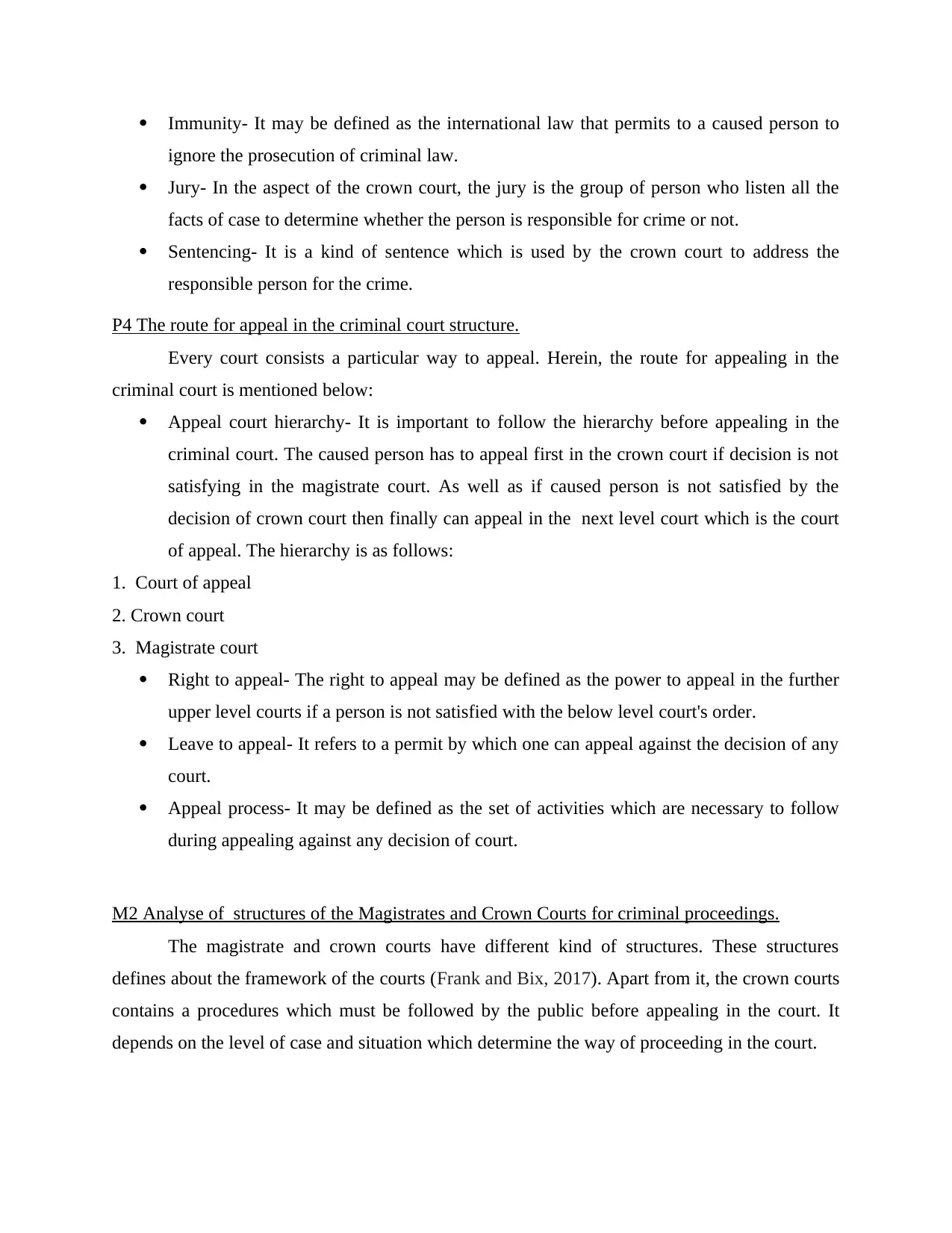
Immunity- It may be defined as the international law that permits to a caused person to
ignore the prosecution of criminal law.
Jury- In the aspect of the crown court, the jury is the group of person who listen all the
facts of case to determine whether the person is responsible for crime or not.
Sentencing- It is a kind of sentence which is used by the crown court to address the
responsible person for the crime.
P4 The route for appeal in the criminal court structure.
Every court consists a particular way to appeal. Herein, the route for appealing in the
criminal court is mentioned below:
Appeal court hierarchy- It is important to follow the hierarchy before appealing in the
criminal court. The caused person has to appeal first in the crown court if decision is not
satisfying in the magistrate court. As well as if caused person is not satisfied by the
decision of crown court then finally can appeal in the next level court which is the court
of appeal. The hierarchy is as follows:
1. Court of appeal
2. Crown court
3. Magistrate court
Right to appeal- The right to appeal may be defined as the power to appeal in the further
upper level courts if a person is not satisfied with the below level court's order.
Leave to appeal- It refers to a permit by which one can appeal against the decision of any
court.
Appeal process- It may be defined as the set of activities which are necessary to follow
during appealing against any decision of court.
M2 Analyse of structures of the Magistrates and Crown Courts for criminal proceedings.
The magistrate and crown courts have different kind of structures. These structures
defines about the framework of the courts (Frank and Bix, 2017). Apart from it, the crown courts
contains a procedures which must be followed by the public before appealing in the court. It
depends on the level of case and situation which determine the way of proceeding in the court.
ignore the prosecution of criminal law.
Jury- In the aspect of the crown court, the jury is the group of person who listen all the
facts of case to determine whether the person is responsible for crime or not.
Sentencing- It is a kind of sentence which is used by the crown court to address the
responsible person for the crime.
P4 The route for appeal in the criminal court structure.
Every court consists a particular way to appeal. Herein, the route for appealing in the
criminal court is mentioned below:
Appeal court hierarchy- It is important to follow the hierarchy before appealing in the
criminal court. The caused person has to appeal first in the crown court if decision is not
satisfying in the magistrate court. As well as if caused person is not satisfied by the
decision of crown court then finally can appeal in the next level court which is the court
of appeal. The hierarchy is as follows:
1. Court of appeal
2. Crown court
3. Magistrate court
Right to appeal- The right to appeal may be defined as the power to appeal in the further
upper level courts if a person is not satisfied with the below level court's order.
Leave to appeal- It refers to a permit by which one can appeal against the decision of any
court.
Appeal process- It may be defined as the set of activities which are necessary to follow
during appealing against any decision of court.
M2 Analyse of structures of the Magistrates and Crown Courts for criminal proceedings.
The magistrate and crown courts have different kind of structures. These structures
defines about the framework of the courts (Frank and Bix, 2017). Apart from it, the crown courts
contains a procedures which must be followed by the public before appealing in the court. It
depends on the level of case and situation which determine the way of proceeding in the court.
Paraphrase This Document
Need a fresh take? Get an instant paraphrase of this document with our AI Paraphraser
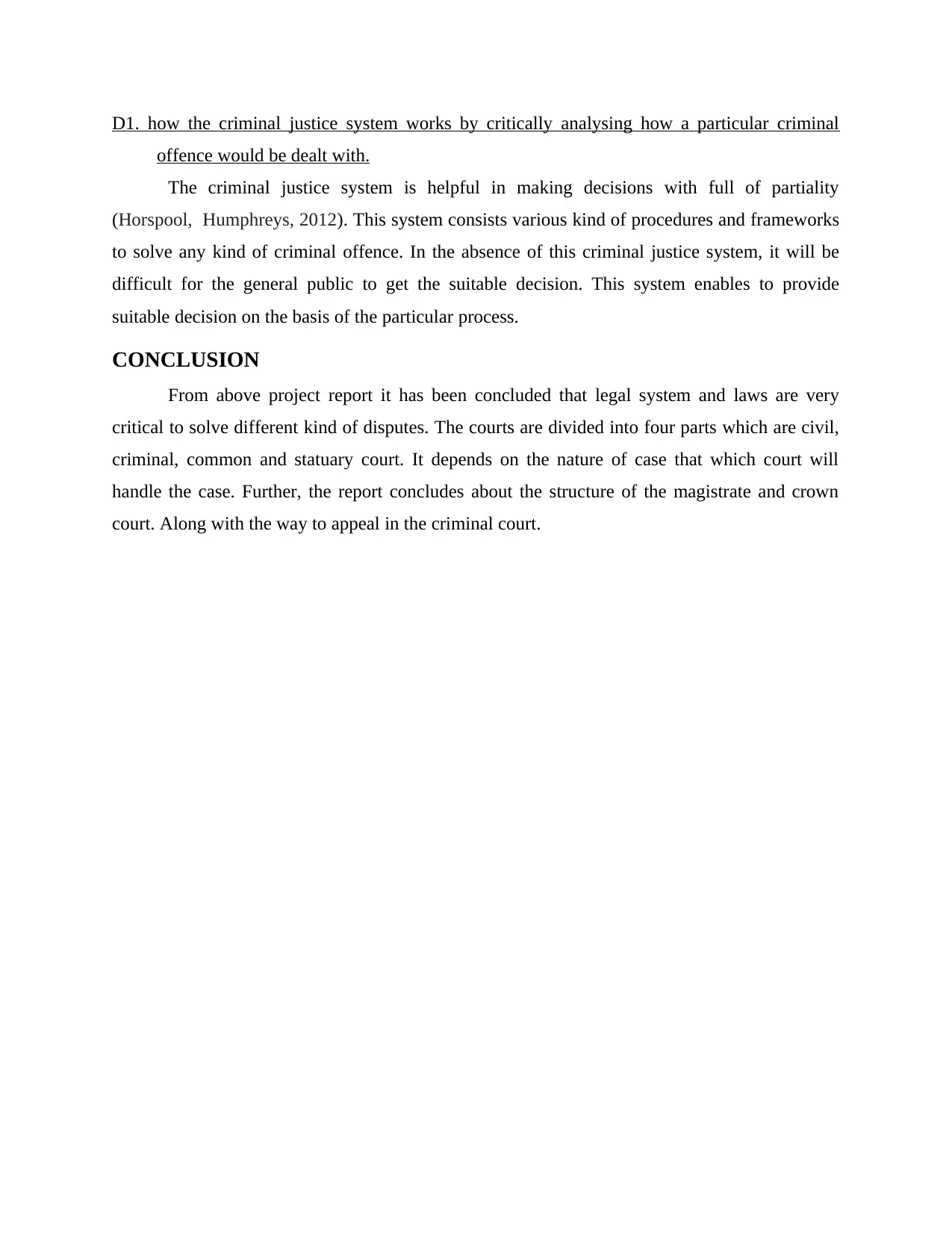
D1. how the criminal justice system works by critically analysing how a particular criminal
offence would be dealt with.
The criminal justice system is helpful in making decisions with full of partiality
(Horspool, Humphreys, 2012). This system consists various kind of procedures and frameworks
to solve any kind of criminal offence. In the absence of this criminal justice system, it will be
difficult for the general public to get the suitable decision. This system enables to provide
suitable decision on the basis of the particular process.
CONCLUSION
From above project report it has been concluded that legal system and laws are very
critical to solve different kind of disputes. The courts are divided into four parts which are civil,
criminal, common and statuary court. It depends on the nature of case that which court will
handle the case. Further, the report concludes about the structure of the magistrate and crown
court. Along with the way to appeal in the criminal court.
offence would be dealt with.
The criminal justice system is helpful in making decisions with full of partiality
(Horspool, Humphreys, 2012). This system consists various kind of procedures and frameworks
to solve any kind of criminal offence. In the absence of this criminal justice system, it will be
difficult for the general public to get the suitable decision. This system enables to provide
suitable decision on the basis of the particular process.
CONCLUSION
From above project report it has been concluded that legal system and laws are very
critical to solve different kind of disputes. The courts are divided into four parts which are civil,
criminal, common and statuary court. It depends on the nature of case that which court will
handle the case. Further, the report concludes about the structure of the magistrate and crown
court. Along with the way to appeal in the criminal court.
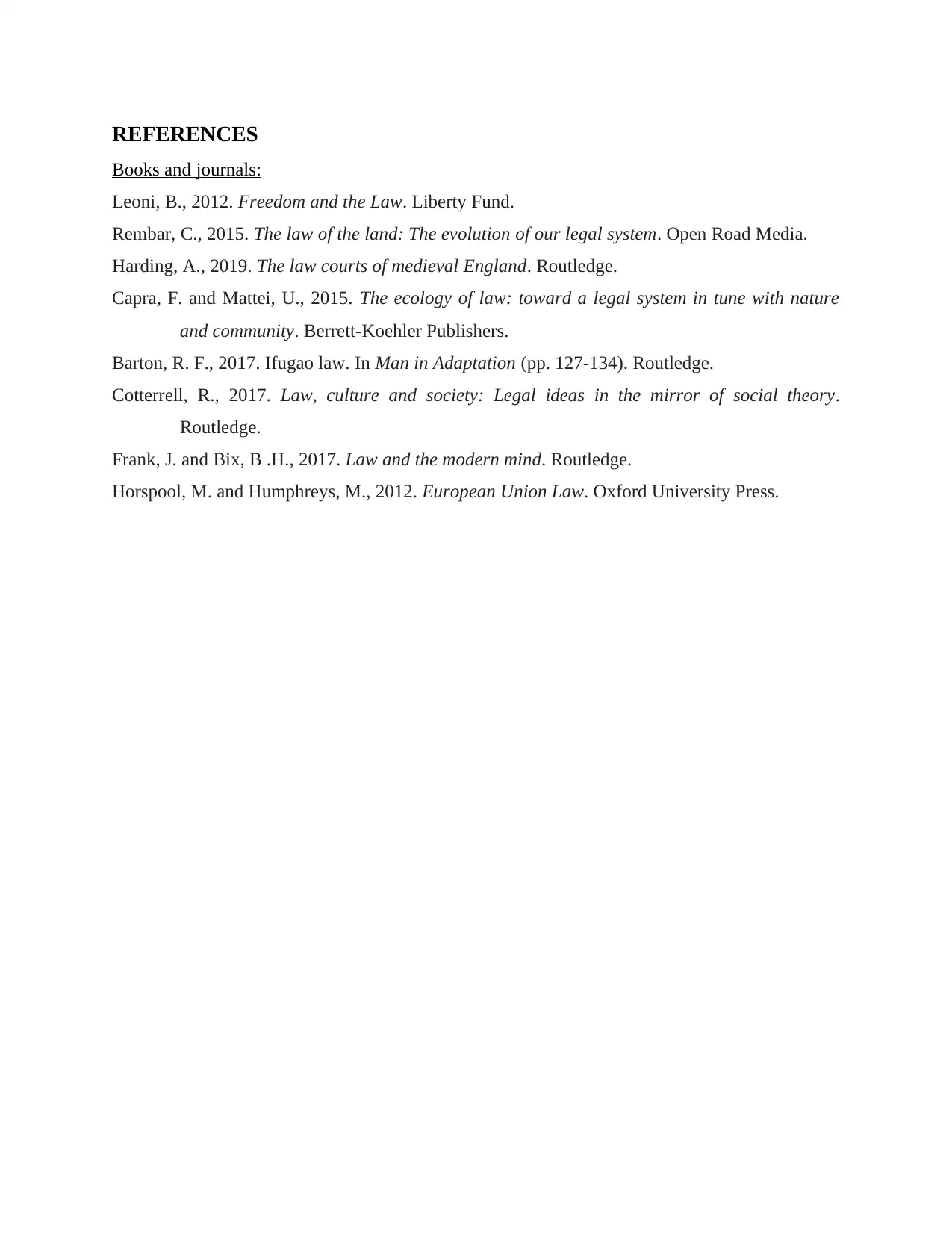
REFERENCES
Books and journals:
Leoni, B., 2012. Freedom and the Law. Liberty Fund.
Rembar, C., 2015. The law of the land: The evolution of our legal system. Open Road Media.
Harding, A., 2019. The law courts of medieval England. Routledge.
Capra, F. and Mattei, U., 2015. The ecology of law: toward a legal system in tune with nature
and community. Berrett-Koehler Publishers.
Barton, R. F., 2017. Ifugao law. In Man in Adaptation (pp. 127-134). Routledge.
Cotterrell, R., 2017. Law, culture and society: Legal ideas in the mirror of social theory.
Routledge.
Frank, J. and Bix, B .H., 2017. Law and the modern mind. Routledge.
Horspool, M. and Humphreys, M., 2012. European Union Law. Oxford University Press.
Books and journals:
Leoni, B., 2012. Freedom and the Law. Liberty Fund.
Rembar, C., 2015. The law of the land: The evolution of our legal system. Open Road Media.
Harding, A., 2019. The law courts of medieval England. Routledge.
Capra, F. and Mattei, U., 2015. The ecology of law: toward a legal system in tune with nature
and community. Berrett-Koehler Publishers.
Barton, R. F., 2017. Ifugao law. In Man in Adaptation (pp. 127-134). Routledge.
Cotterrell, R., 2017. Law, culture and society: Legal ideas in the mirror of social theory.
Routledge.
Frank, J. and Bix, B .H., 2017. Law and the modern mind. Routledge.
Horspool, M. and Humphreys, M., 2012. European Union Law. Oxford University Press.
⊘ This is a preview!⊘
Do you want full access?
Subscribe today to unlock all pages.

Trusted by 1+ million students worldwide
1 out of 9
Related Documents
Your All-in-One AI-Powered Toolkit for Academic Success.
+13062052269
info@desklib.com
Available 24*7 on WhatsApp / Email
![[object Object]](/_next/static/media/star-bottom.7253800d.svg)
Unlock your academic potential
Copyright © 2020–2025 A2Z Services. All Rights Reserved. Developed and managed by ZUCOL.




